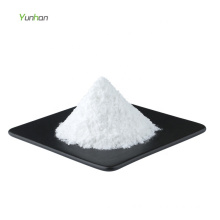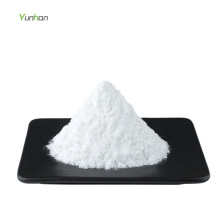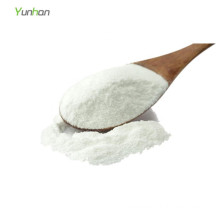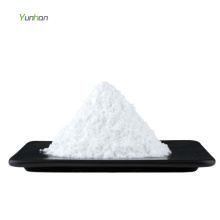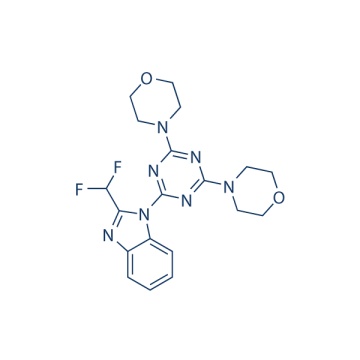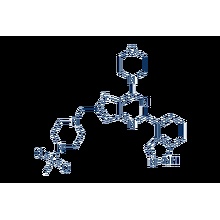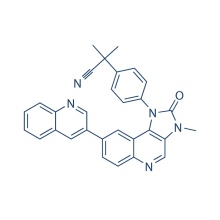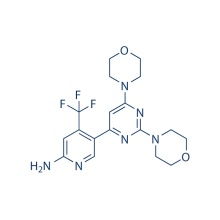ZSTK474 475110-96-4
Product Description
.cp_wz table {border-top: 1px solid #ccc;border-left:1px solid #ccc; } .cp_wz table td{border-right: 1px solid #ccc; border-bottom: 1px solid #ccc; padding: 5px 0px 0px 5px;} .cp_wz table th {border-right: 1px solid #ccc;border-bottom: 1px solid #ccc; padding: 5px 0px 0px 5px;}
Molecular Weight: 417.41 ZSTK474 inhibits class I PI3K isoforms with IC50 of 37 nM, mostly PI3Kδ. Phase1/2.
ZSTK474 at 1 μM potently reduces PI3K activity to 4.7% of the control
level, whereas LY2194002 only reduces the activity to 44.6% of the
control. ZSTK474 inhibits the activities of recombinant p110β, -γ, and
-δ with IC50 of 17 nM, 53 nM, and 6 nM, respectively. ZSTK474 shows
potent antiproliferative activity against a panel of 39 human cancer
cell lines with mean GI50 of 0.32 μM, more effectively than that of
LY294002 or wortmannin with mean GI50 of 7.4 μM or 10 μM, respectively.
ZSTK474 treatment at 1 μM blocks membrane ruffling and generation of
PIP3 induced by platelet-derived growth factor in murine embryonic
fibroblasts (MEFs). ZSTK474 at 10 μM induces Apoptosis in OVCAR3 cells,
and induces complete G1-phase arrest but not apoptosis in A549 cells.
ZSTK474 treatment at 0.5 μM significantly decreases the level of
phosphorylated Akt and GSK-3β, as well as the cyclin D1 protein
expression. ZSTK474 also inhibits the phosphorylation of other
downstream signaling components that are involved in regulating cell
proliferation including FKHRL1, FKHR, TSC-2, mTOR, and p70S6K in a
dose-dependent manner.
ZSTK474 does not inhibit mTOR at 0.1 μM, and even at a concentration of 100 μM, ZSTK474 inhibits mTOR activity less than 40%. ZSTK474 blocks VEGF-induced cell migration and the tube formation in
human umbilical vein endothelial cells (HUVECs), and inhibits the
expression of HIF-1α and secretion of VEGF in RXF-631L cells, exhibiting
potent in vitro antiangiogenic activity. ZSTK474
treatment inhibits the production of IFNγ and IL-17 in concanavalin
A-activated T cells, and inhibits the proliferation and PGE(2)
production by fibroblast-like synovial cells (FLS).
Cell Assay: [1]
Animal Study: [1]
Conversion of different model animals based on BSA (Value based on data from FDA Draft Guidelines)
For example, to modify the dose of resveratrol used for a mouse (22.4 mg/kg) to a dose based on the BSA for a rat, multiply 22.4 mg/kg by the Km factor for a mouse and then divide by the Km factor for a rat. This calculation results in a rat equivalent dose for resveratrol of 11.2 mg/kg.
Chemical Information
Molarity Calculator
Dilution Calculator
Molecular Weight Calculator
Contact us if you need more details on ZSTK474 475110-96-4. We are ready to answer your questions on packaging, logistics, certification or any Other aspects about 475110-96-4 ZSTK474、475110-96-4. If these products fail to match your need, please contact us and we would like to provide relevant information.
Molecular Weight: 417.41 ZSTK474 inhibits class I PI3K isoforms with IC50 of 37 nM, mostly PI3Kδ. Phase1/2.
ZSTK474 at 1 μM potently reduces PI3K activity to 4.7% of the control
level, whereas LY2194002 only reduces the activity to 44.6% of the
control. ZSTK474 inhibits the activities of recombinant p110β, -γ, and
-δ with IC50 of 17 nM, 53 nM, and 6 nM, respectively. ZSTK474 shows
potent antiproliferative activity against a panel of 39 human cancer
cell lines with mean GI50 of 0.32 μM, more effectively than that of
LY294002 or wortmannin with mean GI50 of 7.4 μM or 10 μM, respectively.
ZSTK474 treatment at 1 μM blocks membrane ruffling and generation of
PIP3 induced by platelet-derived growth factor in murine embryonic
fibroblasts (MEFs). ZSTK474 at 10 μM induces Apoptosis in OVCAR3 cells,
and induces complete G1-phase arrest but not apoptosis in A549 cells.
ZSTK474 treatment at 0.5 μM significantly decreases the level of
phosphorylated Akt and GSK-3β, as well as the cyclin D1 protein
expression. ZSTK474 also inhibits the phosphorylation of other
downstream signaling components that are involved in regulating cell
proliferation including FKHRL1, FKHR, TSC-2, mTOR, and p70S6K in a
dose-dependent manner.
ZSTK474 does not inhibit mTOR at 0.1 μM, and even at a concentration of 100 μM, ZSTK474 inhibits mTOR activity less than 40%. ZSTK474 blocks VEGF-induced cell migration and the tube formation in
human umbilical vein endothelial cells (HUVECs), and inhibits the
expression of HIF-1α and secretion of VEGF in RXF-631L cells, exhibiting
potent in vitro antiangiogenic activity. ZSTK474
treatment inhibits the production of IFNγ and IL-17 in concanavalin
A-activated T cells, and inhibits the proliferation and PGE(2)
production by fibroblast-like synovial cells (FLS).
| Inhibition of PI3K activity | A549 cells are lysed in a buffer containing 20 mM Tris-HCl (pH 7.5), 150 mM NaCl, 5 mM EDTA, and 1% Igepal CA-630, the lysates are centrifuged at 20,000 g and 4 °C for 10 minutes, and the supernatants are used as cell lysate (protein = 2-4 mg/mL). To immunoprecipitate PI3K, 200 μL of cell lysate are incubated with anti-p85 polyclonal antibody and protein G-agarose (5 μL). PI3Kα, PI3Kβ, and PI3Kδ can be immunoprecipitated by the anti-p85 polyclonal antibody. Agarose beads containing immunoprecipitates are washed twice with buffer A (20 mM Tris-HCl at pH 7.5, 150 mM NaCl, 5 mM EDTA, and 1% Igepal CA-630), once with buffer B (500 mM LiCl and 100 mM Tris-HCl at pH 7.5), once with distilled water, and once with buffer C (100 mM NaCl and 20 mM Tris-HCl at pH 7.5). Immunoprecipitates are suspended in 20 μL of buffer C containing phosphatidylinositol of 200 μg/mL. The mixture is preincubated with increasing concentrations of ZSTK474 at 25 °C for 5 minutes. [γ-32P]ATP (2 μCi per assay mixture; final concentration, 20 μM) and MgCl2 (final concentration, 20 mM) are added to start the reaction. The reaction mixture is incubated at 25 °C for 20 minutes. Phosphorylated products of phosphatidylinositol are separated by thin-layer chromatography and visualized by autoradiography. The phosphatidylinositol-3-phosphate region is scraped from the plate, and radioactivity is also measured with liquid scintillation spectroscopy. The level of inhibition for ZSTK474 is determined as the percentage of 32P counts per minute obtained without ZSTK474. |
|---|
Cell Assay: [1]
| Cell lines | MCF-7, HT-29, HCT-116, OVCAR3, A549, et al. |
|---|---|
| Concentrations | Dissolved in DMSO, final concentrations ~10 μM |
| Incubation Time | 48 hours |
| Method | Cells are exposed to increasing concentrations of ZSTK474 for 48 hours. The inhibition of cell proliferation is assessed by measuring changes in total cellular protein by use of a sulforhodamine B assay. Apoptosis is assessed by chromatin condensation or by flow cytometry. For chromatin condensation assay, cells are stained with Hoechst 33342 and examined by fluorescence microscopy. Morphologic changes induced by ZSTK474, such as the condensation of chromatin, are indicative of apoptosis. For flow cytometry analysis, cells are harvested, washed with ice-cold PBS, and fixed in 70% ethanol. Cells are then washed twice with ice-cold PBS again, treated with RNase A (500 μg/mL) at 37 °C for 1 hour, and stained with propidium iodide (25 μg/mL). The DNA content of the cells is analyzed with a flow cytometer. |
Animal Study: [1]
| Animal Models | Male BDF1 mice injected subcutaneously with B16F10 cells, and female BALB/c nude mice inoculated subcutaneously with A549, PC-3, or WiDr cells | ||
|---|---|---|---|
| Formulation | Suspended in 5% hydroxypropylcellulose in water as a solid dispersion form | ||
| Dosages | ~400 mg/kg/day | ||
| Administration | Orally | ||
| Solubility | 0.5% hydroxyethyl cellulose, 30 mg/mL | ||
| * Please note that Selleck tests the solubility of all compounds in-house, and the actual solubility may differ slightly from published values. This is normal and is due to slight batch-to-batch variations. | |||
Conversion of different model animals based on BSA (Value based on data from FDA Draft Guidelines)
| Species | Baboon | Dog | Monkey | Rabbit | Guinea pig | Rat | Hamster | Mouse |
| Weight (kg) | 12 | 10 | 3 | 1.8 | 0.4 | 0.15 | 0.08 | 0.02 |
| Body Surface Area (m2) | 0.6 | 0.5 | 0.24 | 0.15 | 0.05 | 0.025 | 0.02 | 0.007 |
| Km factor | 20 | 20 | 12 | 12 | 8 | 6 | 5 | 3 |
| Animal A (mg/kg) = Animal B (mg/kg) multiplied by | Animal B Km |
| Animal A Km |
For example, to modify the dose of resveratrol used for a mouse (22.4 mg/kg) to a dose based on the BSA for a rat, multiply 22.4 mg/kg by the Km factor for a mouse and then divide by the Km factor for a rat. This calculation results in a rat equivalent dose for resveratrol of 11.2 mg/kg.
| Rat dose (mg/kg) = mouse dose (22.4 mg/kg) × | mouse Km(3) | = 11.2 mg/kg |
| rat Km(6) |
Chemical Information
| Molecular Weight (MW) | 417.41 |
|---|---|
| Formula | C19H21F2N7O2 |
| CAS No. | 475110-96-4 |
| Storage | 3 years -20℃Powder |
|---|---|
| 6 months-80℃in solvent (DMSO, water, etc.) | |
| Synonyms | |
| Solubility (25°C) * | In vitro | DMSO | 21 mg/mL (50.31 mM) |
|---|---|---|---|
| Water | <1 mg/mL ( | ||
| Ethanol | <1 mg/mL ( | ||
| In vivo | 0.5% hydroxyethyl cellulose | 30 mg/mL | |
| * <1 mg/ml means slightly soluble or insoluble. * Please note that Selleck tests the solubility of all compounds in-house, and the actual solubility may differ slightly from published values. This is normal and is due to slight batch-to-batch variations. | |||
| Chemical Name | 2-(difluoromethyl)-1-(4,6-dimorpholino-1,3,5-triazin-2-yl)-1H-benzo[d]imidazole |
|---|
Molarity Calculator
Dilution Calculator
Molecular Weight Calculator
Contact us if you need more details on ZSTK474 475110-96-4. We are ready to answer your questions on packaging, logistics, certification or any Other aspects about 475110-96-4 ZSTK474、475110-96-4. If these products fail to match your need, please contact us and we would like to provide relevant information.
Product Categories : PI3K/Akt/mTOR > PI3K Inhibitor
Other Products
Hot Products
Astragaloside AChlortetracycline HCl 64-72-2Paclitaxel 33069-62-4Dexamethasone Acetate 1177-87-3Dinaciclib (SCH727965) 779353-01-4CHIR-124 405168-58-3Ro3280 1062243-51-9TAME 901-47-3CCG-1423 285986-88-110058-F4 403811-55-2Dabigatran (BIBR 953) 211914-51-1H 89 2HCl 130964-39-5T0901317 293754-55-9Aprepitant 170729-80-3Turofexorate Isopropyl (XL335) 629664-81-9BMS-378806 357263-13-9

